The throw pillow (also known as an accent or decorative pillow) is a classic part of everyone’s sofa set-up. And they’re not just about comfort. Throw pillows are a great way to add some design flare to your couch and your living room, too. Today we’re talking all about throw pillows, how to choose them and how many to choose. But first, let’s dive into some ground rules.
The Four Rules of Choosing Throw Pillows
- Mix and match to your heart’s content but do it with a plan in mind.
- Make sure the different textiles, sizes, patterns and colors complement each other and don’t compete.
- Take inspiration from key elements of your living space (i.e. your couch, an accent wall, wallpaper)
- Combine patterns and prints with neutrals or plain colors to break things up.
Types of Decorative Accent Pillows
Just like there are different types of couches, there are several types of throw pillows to choose from. The difference is that with pillows, you can mix and match to create a combination that really brings life to your couch. In order to do that, we’ve got to have a basic understanding of the decorative throw pillow options available to us.

Square Pillows
Square pillows are a classic throw pillow shape and are probably the most common you’ll come across. You really can’t go wrong with this shape and it can fit many styles depending on the size, color and materials you choose.

Round Pillows
Round pillows are a great way to add a bit of decoration, especially to more traditionally styled couches. Some may come tufted with a button in the center, while others may be ruched, pleated or flat.
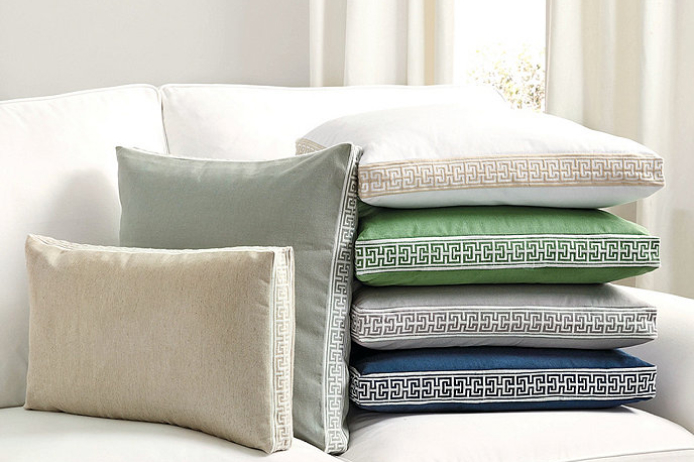
Bolster Pillows
The bolster pillow is a cylindrical pillow that offers back or neck support in addition to style. Use fabric that matches the upholstery of your couch for a more traditional look or throw in a pop of color to modernize the space.
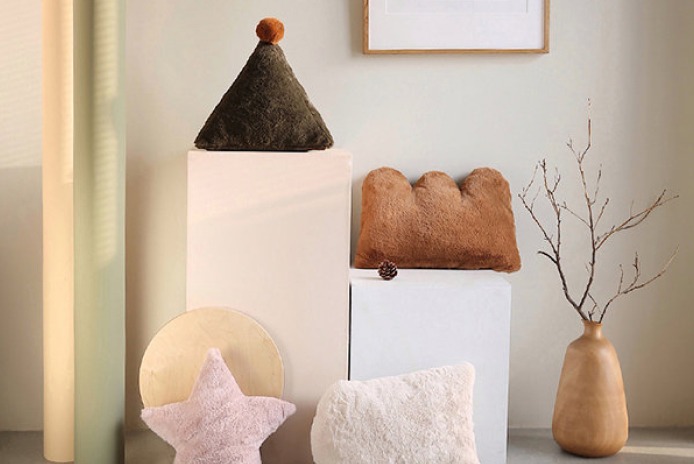
Box Pillows
The box pillow is characterized by flat sides, creating a box-like look. Usually the flat sides are narrow, so the pillow is still able to lay flat. These pillows are great for more modern couch styles that rely on sharp, crisp edges. They can also be used as floor pillows, too.
How Many Pillows To Use On Your Couch?
There’s no hard and fast rule for how many decorative pillows to add to your sofa. It really can come down to preference. Some people prefer lots of pillows in different shapes and sizes, while others prefer one to two simple pieces to add a bit of color. Use other pillows in your house to test what multiple pillows would look like on your couch and consider how the volume of pillows could impact comfort or the number of people the sofa can seat.
Types of Throw Pillow Fill
There’s no hard and fast rule for how many decorative pillows to add to your sofa. It really can come down to preference. Some people prefer lots of pillows in different shapes and sizes, while others prefer one to two simple pieces to add a bit of color. Use other pillows in your house to test what multiple pillows would look like on your couch and consider how the volume of pillows could impact comfort or the number of people the sofa can seat.
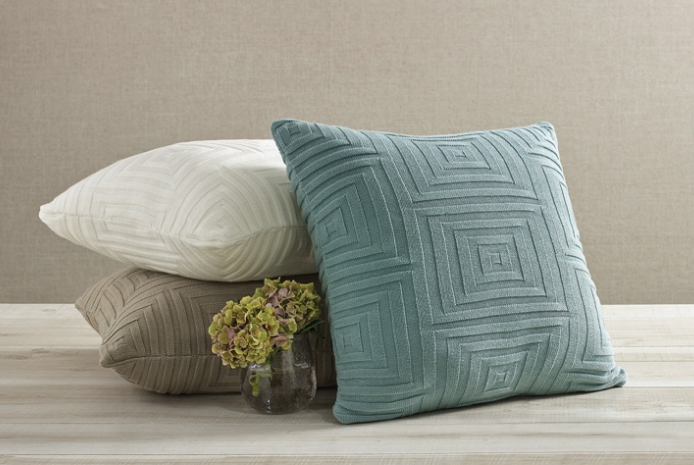
Polyester
Polyester is a synthetic material and probably the most common fill for throw pillows. This fiber filling tends to be cheaper, lightweight and well insulated, but can often leave your pillow feeling very warm. Some pillows are made with more natural outer fabrics, but filled with polyester, to cut down on costs.
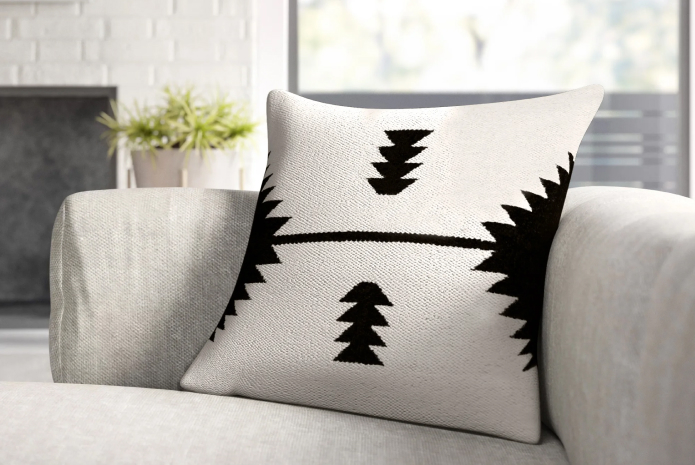
Down
When a pillow is filled with down, that means it’s made with the feathers of a goose or duck. Down filled pillows are typically fluffy, light, and great for people who need more natural fabrics – but they can be expensive. Down pillows come in a rating system that describes the quality and amount of down inside.

Foam
Foam pillows are more common in bed pillows but can be used for couch pillows as well. Since foam holds its shape better than polyester and down, it’s great for circle and bolster pillows. There are even memory foam throw pillows available for maximum couch comfort.
Finishes, Textures & Edges
Once you’ve decided on the shape or shapes you want to use, it’s time to consider the different ways each shape can come to life. Remember, you can mix and match, but it’s important to not overdo it. Your pillows should complement, not compete with each other.

Knife Edge Pillows
A knife edge seam is when the two edges of fabric come together in a clean, straight line without any fancy trimmings. This is the most common way a pillow is finished.
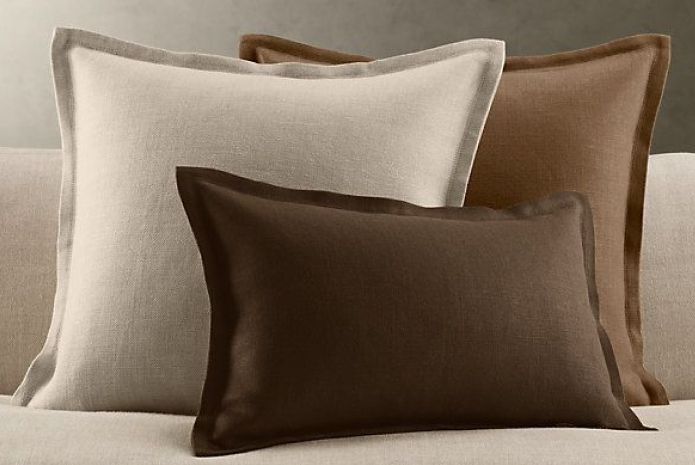
Flanged Pillows
When a pillow has a flange edge, it has a 1/2’’ to 3’’ decorative border around all edges, usually constructed with the same fabric the main pillow is made with. This style is a classic and perfect for more traditional spaces.

Welted or Corded
A welted or corded pillow is one that has a rounded edge on the seam, usually accomplished with a cord that is covered in the same fabric as the rest of the pillow. This gives a nice, tailored look and is great when paired with couches that are similarly tailored or feature crisp lines.
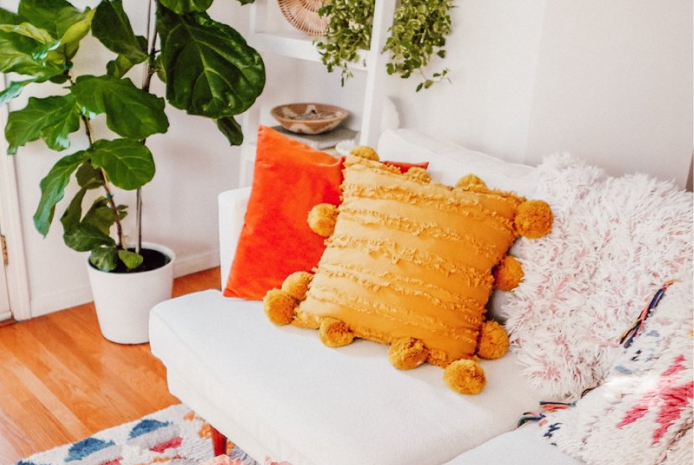
Tassels and Pompoms
Tassels and pompoms are very popular right now and can add a boho, beachy, whimsical or childlike look depending on the size and color you choose. Consider mixing a tasseled or pompom pillow with more simple pillows for a good contrast in styles.
Common Throw Pillow Materials
There are a ton of materials to choose from, each with their own pros and cons. Feel free to mix and match here as well, while keeping some additional rules in mind. First, try not to mix fabrics that are very clearly in different styles like burlap and velvet, or faux fur and corduroy. Second, try not to mix too many textiles together without a clear design in mind. Instead, choose 1-2 you like the best and work from there. You could end up with four different fabric types, which is great for a contemporary look. Or, for a more traditionally look, you can get custom throw pillow covers that match identically to your couch’s upholstery fabric.
Here are some common pillow fabric types to start your creative wheels turning:
- Cotton – A classic, casual fabric that’s easy to clean
- Polyester – Super durable, versatile fabric, great for traditional looks
- Burlap – A rustic, country feel and an easy way to add texture
- Linen – Great for a light, beachy look
- Velvet – Elegant and adds warmth to the space
- Satin & Silk – Sleek, but high-maintenance fabrics that are good for traditional styles
- Chenille – Delicate, soft, more formal fabric that can often shed
- Faux fur –?A great way to add personality and drama
- Leather – Sleek, sophisticated and stylishly modern
- Suede – Soft, modern way to add style and drama
- Wool – cozy, think fabric that’s great for patterns
- Sequin – a fun way to add flair and texture to contemporary styles
Color & Patterns
Color and patterns can tone down or jazz up a space. While you’re considering your options, think about the different parts of the room you want to call attention to (it’s not always your couch). For example, you could match your throw pillows with a colored accent wall or to an heirloom piece of furniture. However, you can use your couch as your main inspiration. If you have a more muted couch color, your throw pillows are a great place to bring in a pop of color or use a funky pattern to add some flair. One the other hand, more neutral pillows can be used to balance a bolder couch color or complement a classic, clean style.
Patterns can be a fun way to play with your design palette, too. Consider mixing pillows with patterns of similar colors or choosing different colors of the same pattern. Your living space can be a source of inspiration here, too. Your throw pillows could match the pattern of your wallpaper, boho tapestry, etc.
Fabric Textures
Different textures can change the look of a pillow dramatically. Consider a velvet circle pillow, for instance. When made with pleats and button center, it can give off a more regal, decadent feel. When made smooth with a knife-edge finish, it’s a more contemporary look. And when made to match the upholstery of your couch, it’s more traditional.